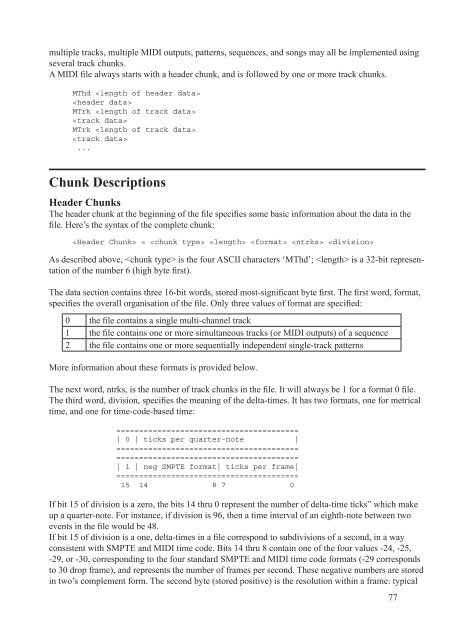2.3 Relaxatie-oscillator
2.3 Relaxatie-oscillator
2.3 Relaxatie-oscillator
Create successful ePaper yourself
Turn your PDF publications into a flip-book with our unique Google optimized e-Paper software.
multiple tracks, multiple MIDI outputs, patterns, sequences, and songs may all be implemented using<br />
several track chunks.<br />
A MIDI file always starts with a header chunk, and is followed by one or more track chunks.<br />
MThd <br />
<br />
MTrk <br />
<br />
MTrk <br />
<br />
...<br />
Chunk Descriptions<br />
Header Chunks<br />
The header chunk at the beginning of the file specifies some basic information about the data in the<br />
file. Here’s the syntax of the complete chunk:<br />
= <br />
As described above, is the four ASCII characters ‘MThd’; is a 32-bit representation<br />
of the number 6 (high byte first).<br />
The data section contains three 16-bit words, stored most-significant byte first. The first word, format,<br />
specifies the overall organisation of the file. Only three values of format are specified:<br />
0 the file contains a single multi-channel track<br />
1 the file contains one or more simultaneous tracks (or MIDI outputs) of a sequence<br />
2 the file contains one or more sequentially independent single-track patterns<br />
More information about these formats is provided below.<br />
The next word, ntrks, is the number of track chunks in the file. It will always be 1 for a format 0 file.<br />
The third word, division, specifies the meaning of the delta-times. It has two formats, one for metrical<br />
time, and one for time-code-based time:<br />
========================================<br />
| 0 | ticks per quarter-note |<br />
========================================<br />
========================================<br />
| 1 | neg SMPTE format| ticks per frame|<br />
========================================<br />
15 14 8 7 0<br />
If bit 15 of division is a zero, the bits 14 thru 0 represent the number of delta-time ticks” which make<br />
up a quarter-note. For instance, if division is 96, then a time interval of an eighth-note between two<br />
events in the file would be 48.<br />
If bit 15 of division is a one, delta-times in a file correspond to subdivisions of a second, in a way<br />
consistent with SMPTE and MIDI time code. Bits 14 thru 8 contain one of the four values -24, -25,<br />
-29, or -30, corresponding to the four standard SMPTE and MIDI time code formats (-29 corresponds<br />
to 30 drop frame), and represents the number of frames per second. These negative numbers are stored<br />
in two’s complement form. The second byte (stored positive) is the resolution within a frame: typical<br />
77


